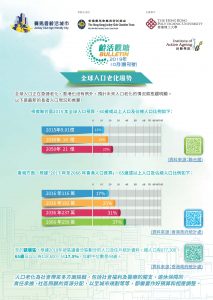Kwun Tong Age-friendly Bulletin (齡活觀塘 Bulletin)

Status: Ongoing
Evaluated
Summary
To promote the awareness of age-friendliness in Kwun Tong District, the Institute of Active Ageing at The Hong Kong Polytechnic University, commissioned as the Professional Support Team of the Jockey Club Age-Friendly City (“JCAFC”) Project, has published six issues of the quarterly Kwun Tong Age-friendly Bulletin (in Chinese) from October 2019 to April 2021 to disseminate useful information and highlight the voices of older adults in the community.
The Bulletin includes the following components:
- Thematic reports on age-friendly domains, findings of related studies, policies and application measures in Hong Kong
- Progress of the JCAFC Project, e.g. public education events and materials, etc.
- Updates of age-friendly practices in Kwun Tong District to appreciate past efforts and prompt areas for improvement
- Information on available age-friendly resources and services.
- Domain-specific tips to improve the tangible and intangible elements of daily life, e.g. safe and convenient furniture setting at home, etc.
- Voices of elderly individuals and groups to reflect concerns about age-friendliness
The target audience of the Bulletin includes older people and stakeholders of different sectors, such as the District Council, government departments, local organizations, etc. for inducing change at different levels to improve the quality of life of older people. Meanwhile, older adults, their care-givers and general public can gain knowledge about ageing life to actualise daily practices of age-friendliness.
Over 800 e-copies and 8,000 printed copies of the Bulletin were delivered to different organizations for reference, display and public access. Moreover, every issue was uploaded to the JCAFC Project Facebook page.
https://www.facebook.com/page/510308289351566/search/?q=%E9%BD%A1%E6%B4%BB%E5%8D%81%E5%85%AB%E5%8D%80
Key facts
Older people in general
District Councillors, Elderly Service NGOs, Related Government Departments e.g. Social Welfare, Public Housing Estate Management, General Public e.g. Residents of Public Housing Estates, Elderly Service Recipients, etc.
Health, Housing, Information and communication, Transportation, Urban development
Learn, grow and make decisions
- Ageism
- Accessibility
- Ageing in place
- Healthy behaviours (e.g. physical activity)
- Intergenerational activities
- Inclusion
- Participation
- Technologies
- Other
Respect and Social Inclusion
Age-friendly practice in detail (click to expand):
Engaging the wider community
Research institution
- Local authorities
- Civil Society Organisation
- Older People’s Association
- Social or health care provider
- Volunteers
- Private sector
1. The Hong Kong Jockey Club Charities Trust funded the program;
2. The Hong Kong Polytechnic University produced the Bulletin;
3. The elderly service NGOs help to provide information; and
4. The District Councillors, district offices of related government departments, elderly service NGOs and housing estate management offices help to distribute the Bulletin to more stakeholders and public.
Older people were consulted during the planning process
Older people are invited to share on the matters of their concerns, which are shown in the “elderly voice” section of every issue of the Bulletin.
Moving forward
Yes
Positive
Positive impact:
1. Increased knowledge on age-friendliness;
2. More attention paid to age-friendly environment around their neighbourhood;
3. Increased knowledge on age-friendliness resources in the district and attempts to utilize; and
4. Increased knowledge on the coping methods to daily lives and attempts to practice for themselves and other older people.
Suggestions for improvement:
1. The colour of the background of each issue should be different for easy identification;
2. More in-depth study on specific ageing issues could be conducted;
3. QR codes may not be user-friendly for older people and they may appear confusing to readers; and
4. More promotion on the bulletin should be carried out for reaching more readers.
Feedback has been collected from a survey and discussion held with older group members and NGO personnels.
Actions are being planned to expand the age-friendly practice in the following aspects:
1. To transfer knowledge among the stakeholders by publishing age-friendly information profile of Kwun Tong district; and
2. To gather more user-centric views on improving age-friendliness by involving older people groups in suitable opinion platforms.
Looking back
The practice of producing both e-version and printed version are suitable. The e-version can be circulated widely and be accessible to more readers in general; while the printed copy would be more convenient for older people who are not familiar with using computers.
The suggestions collected from the feedback will be considered and observed wherever feasible.
Challenges:
1. The thematic report should be intensive and concise in order to be readable by targets with various background;
2. The updates on the district features of age-friendliness require huge amount of information; and
3. Distribution channels seem limited.
Resolutions:
1. Infographs, relevant photos and drawings have been employed to enhance reading interest. Hyper-links embedded on e-version and QR codes shown on printed version for acquiring in-depth information such as study report and policy background;
2. Wide desktop research, onsite observation and telephone interview with relevant persons were helpful on collecting suitable information; and
3. Contacts with recipient agencies from time to time to request forwarding messages and distributing the bulletin to more prospective readers.


